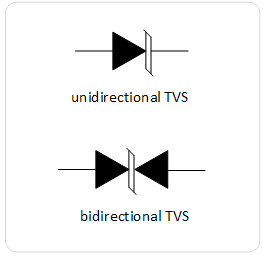Voltage suppressors are used to protect circuits from unwanted transients, when other devices like diodes and capacitors fail to do so. Transient effects have various sources and are able to damage the connected parts and ICs if not properly measures taken. In this article we will discuss about the various transient voltage suppressors and their uses. We will cover, TVSs, Varistors, Multilayer Varistors, Surgestors and Polyswitches etc.
Bypass Capacitors
Bypass capacitors are very often used in logic and power systems to reduce unwanted voltages to reach ICs and other sensitive parts and to clean the power rails, but are limited to low power applications such as RC snubbers and decoupling of digital logic rails. For decoupling a digital rail a capacitor in the range of 0.01-0.22uF is often used and for decoupling a power rail a 0.1uF and up is used, connected form power line to ground. Capacitors are low cost, simple to apply, have fast action and are bipolar but have uneven suppression and may fail unpredictably.
Zener Diodes
Zener diodes are also used to protect sensitive circuits from unwanted voltages in a way of clamping low energy systems that run at high frequencies such as high speed data lines. They are low cost, fast in action, have specific clamping voltage, they are easy to be used and work bidirectional, but can only handle low energy and fail open (which can hurt the circuit). They are mostly used for regulation than transients.
Transient Voltage Suppressor Diodes (TVS)
Transient voltage suppressor diodes or TVSs are semiconductor devices used to clamp transient voltages and current, such as electrostatic discharge, inductive switching kickback, induced lighting surges etc. TVS are used for diversion or clamping in low voltage and low energy, modest frequency systems and are way more reliable than a diodes. They come in unipolar and bipolar versions. Unipolar TVS breaks down when the specified breakdown voltage is exceeded and pass current in one direction, in the opposite direction of the arrow. In contrast bipolar TVS can handle current in both directions. TVS are invisible to the circuit they are placed to until a transient appears. When a transient appears, TVS clamps instantly to limit the spike to a safe voltage level. The breakdown voltage of TVS should be selected to have a breakdown voltage greater than the working voltage of the circuit protecting. Some of the advantages of TVS is that they are fast, easy to use and fail with short-circuit. Some of the disadvantages is that their high capacitance limits the frequency they can be used, they can be used in low energy systems and are more expensive than Zener diodes and MOVs.
Metal Oxide Varistors (MOVs)
Metal oxide varistor or MOV is a bidirectional semiconductor device that acts like a voltage sensitive variable resistor. It’s made of various metal oxide p-n junctions placed in various directions and when the voltage across its leads exceeds a specified voltage they appear to have a very small resistance. The breakdown voltage is defined during the manufacturing process and can pass current in both directions, so can be used in DC and AC circuits. MOVs are fast, low cost, easy to use and handle more power than TVS. Also when they fail they short circuit. The disadvantage of MOVs is that they have moderate to high capacitance, thus limiting their use in lower frequency systems. MOVs are usually placed across mains input along with a series filter inductor and a fuse to protect the MOV itself. When a transient appears they switch from high resistance to low resistance this passing the excess current through. They can absorb a large amount of power for short periods of time and smaller amount of power for longer periods.
For more detail: Transient Voltage Suppressors

